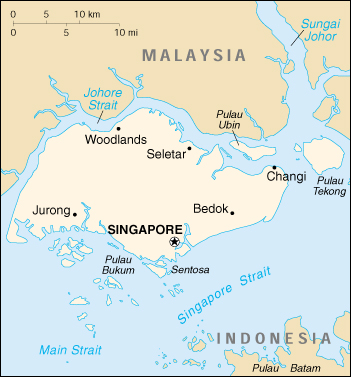


 |
Singapore |  |
| Introduction Geography People Government Economy Communications Transportation Military Transnational Issues Print This Frame | ||
 |
||
| Singapore | Introduction | Top of Page |
| Background: | Founded as a British trading colony in 1819, Singapore joined Malaysia in 1963, but withdrew two years later and became independent. It subsequently became one of the world's most prosperous countries, with strong international trading links (its port is one of the world's busiest) and with per capita GDP above that of the leading nations of Western Europe. |
| Singapore | Geography | Top of Page |
| Location: | Southeastern Asia, islands between Malaysia and Indonesia |
| Geographic coordinates: | 1 22 N, 103 48 E |
| Map references: | Southeast Asia |
| Area: |
total:
647.5 sq km
land: 637.5 sq km water: 10 sq km |
| Area - comparative: | slightly more than 3.5 times the size of Washington, DC |
| Land boundaries: | 0 km |
| Coastline: | 193 km |
| Maritime claims: |
exclusive fishing zone:
within and beyond territorial sea, as defined in treaties and practice
territorial sea: 3 NM |
| Climate: | tropical; hot, humid, rainy; two distinct monsoon seasons - Northeastern monsoon from December to March and Southwestern monsoon from June to September; inter-monsoon - frequent afternoon and early evening thunderstorms |
| Terrain: | lowland; gently undulating central plateau contains water catchment area and nature preserve |
| Elevation extremes: |
lowest point:
Singapore Strait 0 m
highest point: Bukit Timah 166 m |
| Natural resources: | fish, deepwater ports |